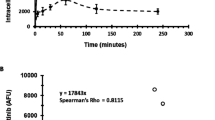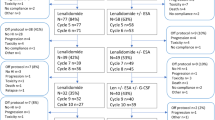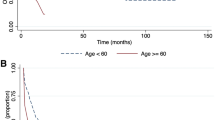Abstract
Anthracyclines trigger an apoptotic cell death but their molecular targets are not totally explored. We investigated the apoptotic response of blast cells and lymphocytes from medullary samples of 31 de novo acute leukemia. Mononuclear cells were treated in vitroby therapeutic concentrations of either daunorubicin (DNR) or idarubicin (IDA) for 1 h, washed and cultured for 18 h. A multivariate analysis using flow cytometry and a CD45 gating on lymphocytes and blast cells was performed. DNR and IDA induced a Fas enhancement on both leukemic and normal cells. In blast cells the DEVDases were activated and the caspase 3 was cleaved in relation to phosphatidyl serine exposure, showing a caspase-dependent pathway in anthracycline-induced apoptosis. Apoptotic percentages were always higher for blast cells than for lymphocytes, confirming that anthracycline toxicity mainly affected tumor cells. Moreover, drug-induced apoptosis was not related to spontaneous apoptosis, suggesting that variations in response intensities were due to individual variations of sensitivity rather than to programmed life span time. The apoptotic response of P- glycoprotein-expressing blast cells was not significant, giving biological argument for the poor prognosis of multidrug resistance leukemia. Finally, Fas induction and anthracycline-induced apoptosis on blast cells were significantly higher when a complete remission was achieved, thus shedding light on potential new prognostic factors in acute leukemia.
This is a preview of subscription content, access via your institution
Access options
Subscribe to this journal
Receive 12 print issues and online access
$259.00 per year
only $21.58 per issue
Buy this article
- Purchase on Springer Link
- Instant access to full article PDF
Prices may be subject to local taxes which are calculated during checkout





Similar content being viewed by others
References
Nagata S . Apoptosis by death factor Cell 1997 88: 355–365
Chinnaiyan AM, O'Rourke K, Tewari M, Dixit VM . FADD, a novel death domain-containing protein, interacts with the death domain of Fas and initiates apoptosis Cell 1995 81: 505–512
Boldin MP, Varfolomeev EE, Pancer Z, Mett IL, Camonis JH, Wallach D . A novel protein that interacts with the death domain of Fas/APO1 contains a sequence motif related to the death domain J Biol Chem 1995 270: 7795–7798
Boldin MP, Goncharov TM, Goltsev YV, Wallach D . Involvement of MACH, a novel MORT1/FADD-interacting protease, in Fas/APO-1- and TNF receptor-induced cell death Cell 1996 85: 803–815
Muzzio M, Chinnaiyan AM, Kischkel FC, O'Rourke K, Shevchenko A, Ni J, Scaffidi C, Bretz JD, Zhang M, Gentz R, Mann M, Krammer PH, Peter ME, Dixit VM . FLICE, a novel FADD-homologous ICE/CED-3-like protease, is recruited to the CD95 (Fas/APO-1) death-inducing signaling complex Cell 1996 85: 817–827
Medema JP, Scaffidi C, Kischkel FC, Shevchenko A, Mann M, Krammer PH, Peter ME . FLICE is activated by association with the Cd95 death-inducing signaling complex (DISC) EMBO J 1997 16: 2794–2804
Thornberry NA, Lazebnik Y . Caspases: enemies within Science 1998 281: 1312–1316
Solary E, Micheau O, Dimanche-Boitrel MT, Martin F . Role of the Fas/Fas-L system in the immune response to tumors and the resistance to cytotoxic drugs Bull Cancer 1998 85: 685–694
Dirks W, Schöne S, Uphoff C, Quentmeier H, Pradella S, Drexler HG . Expression and function of CD95 (Fas/APO-1) in leukemia–lymphoma tumour lines Br J Haematol 1997 96: 584–593
Keane MM, Ettenberg SA, Lowrey GA, Russell EK, Lipkowirz S . Fas expression and function in normal and malignant breast cell lines Cancer Res 1996 56: 4791–4798
Landowski TH, Gleason-Guzman MC, Dalton WS . Selection for drug resistance to Fas-mediated apoptosis Blood 1997 89: 1854–1861
Eischen CM, Kottke TJ, Martins LM, Basi GS, Tung JS, Earnshaw WC, Leibson PJ, Kaufmann SH . Comparison of apoptosis in wild-type and Fas-resistant cells: chemotherapy-induced apoptosis is not dependent on Fas/Fas-ligand interactions Blood 1997 90: 935–943
Mizutani Y, Okada Y, Yoshida O, Fukumoto M, Bonavida B . Doxorubicin sensitizes human bladder carcinoma cells to Fas-mediated cytotoxicity Cancer 1997 79: 1180–1189
Morimoto H, Yonehara S, Bonavida B . Overcoming tumor necrosis factor and drug resistance of human cell lines by combination treatment with anti-Fas antibody and drugs or toxins Cancer Res 1993 53: 2591–2596
Nakamura S, Takeshima M, Nakamura Y, Ohtake S, Matsuda T . Induction of apoptosis in HL60 leukemic cells by anticancer drugs in combination with anti-Fas monoclonal antibody Anticancer Res 1997 17: 173–179
Uslu R, Jewett A, Bonavida B . Sensitization of human ovarian tumor cells by subcytotoxic CDDP to anti-Fas antibody-mediated cytotoxicity and apoptosis Gynecol Oncol 1996 62: 232–291
Micheau O, Solary E, Hammann A, Martin F, Dimanche-Boitrel MT . Sensitization of cancer cells treated with cytotoxic drugs to Fas-mediated cytotoxicity J Natl Cancer Inst 1997 89: 783–789
Kimura H, Yamaguchi Y . A phase III randomized study of interleukin-2 lymphokine-activated killer cell immunotherapy combined with chemotherapy or radiotherapy after curative or noncurative resection of primary lung carcinoma Cancer 1997 80: 42–49
Ling YH, Priebe W, Perez-Soler R . Apoptosis induced by anthracycline antibiotics in P388 parent and multidrug-resistant cells Cancer Res 1993 53: 1845–1852
Skladanowski A, Konopa J . Adriamycin and daunomycin induce programmed cell death (apoptosis) in tumour cells Biochem Pharmacol 1993 46: 375–382
Zaleskis G, Berleth E, Verstovsek S, Ehrke MJ, Mihich E . Doxorubicin-induced DNA degradation in murine thymocytes Mol Pharmacol 1994 46: 901–908
Gewirtz DA . A critical evaluation of the mechanisms of action proposed for the antitumor effects of the anthracycline antibiotics adriamycin and daunorubicin Biochem Pharmacol 1999 57: 727–741
Vial JP, Belloc F, Dumain P, Besnard S, Lacombe F, Boisseau MR, Reiffers J, Bernard P . Study of the apoptosis induced in vitro by antitumoral drugs on leukemic cells Leukemia Res 1997 21: 163–172
Durrieu F, Belloc F, Lacoste L, Dumain P, Chabrol J, Dachary-Prigent J, Morjani H, Boisseau MR, Reiffers J, Bernard P, Lacombe F . Caspase activation is an early event in anthracycline-induced apoptosis and allows detection of apoptotic cells before they are ingested by phagocytes Exp Cell Res 1998 240: 165–175
Friesen C, Fulda S, Debatin KM . Deficient activation of the CD95 (APO-l/Fas) system in drug-resistant cells Leukemia 1997 11: 1833–1841
Friesen C, Herr I, Krammer PH, Debatin KM . Involvement of the CD95 (APO-1/Fas) receptor/ligand system in drug-induced apoptosis in leukemia cells Nature Med 1996 2: 574–577
Müller M, Strand S, Hug H, Heinemann EM, Walczak H, Hofmann WJ, Stremmel W, Krammer PH, Galle PR . Drug-induced apoptosis in hepatoma cells is mediated by the CD95 (APO-1/Fas) receptor/ligand system and involves activation of wild-type p53 J Clin Invest 1997 99: 403–413
Droin N, Dubrez L, Eymin B, Renvoizé C, Breard J, Dimanche-Boitrel MT, Solary E . Upregulation CASP genes in human tumor cells undergoing etoposide-induced apoptosis Oncogene 1998 16: 2885–2894
Yu DK . The contribution of P-glycoprotein to pharmacokinetic drug–drug interactions J Clin Pharmacol 1999 39: 1203–1211
Praet M, Stryckmans P, Ruysschaert JM . Cellular uptake, and transport kinetics of anthracyclines in human sensitive and multidrug-resistant K562 cells Biochem Pharmacol 1996 51: 1341–1348
Gottesman MM, Pastan I . Biochemistry of multidrug resistance mediated by the multidrug transporter Ann Rev Biochem 1993 62: 385–425
Frankfurt OS, Seckinger D, Sugarbaker EV . Pleiotropic drug resistance and survival advantage in leukemia cells with diminished apoptotic response Int J Cancer 1994 59: 217–224
Bennett JM, Catovsky D, Daniel MT, Flandrin G, Galton DAG, Gralnick HR, Sultan C . Proposal for the classification of the acute leukaemias Br J Haematol 1976 33: 451–458
Lacombe F, Durrieu F, Briais A, Dumain P, Belloc F, Bascans E, Reiffers J, Boisseau MR, Bernard P . Flow cytometry CD45 gating for immunophenotyping of acute myeloid leukemia Leukemia 1997 11: 1878–1886
Belaud-Rotureau MA, Lacombe F, Durrieu F, Vial JP, Lacoste C, Bernard P, Belloc F . Ceramide-induced apoptosis occurs independently of caspases and is decreased by leupeptin Cell Death Differ 1999 6: 788–795
Kuwazuru Y, Yoshimura A, Hanada S, Utsunomiya A, Makino T, Ishibashi K, Kodama M, Iwahashi M, Arima T, Akiyama S . Expression of the multidrug transporter, P-glycoprotein, in acute leukemia cells and correlation to clinical drug resistance Cancer 1990 66: 868–873
Martin SJ, Green DR . Protease activation during apoptosis: death by a thousand cuts? Cell 1995 82: 349–352
Green DR . Apoptotic pathways: the roads to ruin Cell 1998 94: 695–698
Zubrod CG . Treatment of the acute leukemias Cancer Res 1967 27: 2557–2560
Robert J, Gianni L . Pharmacokinetics and metabolism of anthracyclines Cancer Surv 1993 17: 219–251
Borchmann P, Hubel K, Schnell R, Engert A . Idarubicin: a brief overview on pharmacology and clinical use Int J Clin Pharmacol Ther 1997 35: 80–83
Campos L, Guyotat D, Archimbaud E, Calmard-Oriol P, Tsuruo T, Troncy J, Treille D, Fiere D . Clinical significance of multidrug resistance P-glycoprotein expression on acute nonlymphoblastic leukemia cells at diagnosis Blood 1992 79: 473–476
Leith CP, Kopecky KJ, Chen IM, Eijdems L, Slovak ML, McConnell TS, Head DR, Weick J, Grever MR, Appelbaum FR, Willman CL . Frequency and clinical significance of the expression of the multidrug resistance proteins MDR1/P-glycoprotein, MRP1, and LRP in acute myeloid leukemia. A Southwest Oncology Group study Blood 1999 94: 1086–1099
Coon JS, Wang Y, Bines SD, Markham PN, Chong ASF, Gebel HM . Multidrug resistance activity in human lymphocytes Hum Immunol 1991 32: 134–140
Drach D, Zhao S, Drach J, Mahadevia R, Gattringer C, Huber H, Andreeff M . Subpopulations of normal peripheral blood and bone marrow cells express a functional multidrug resistance phenotype Blood 1992 80: 2729–2734
Klimeckj WT, Furscher BW, Grogan TM, Dalton WS . P-glycoprotein expression and function in circulating blood cells from normal volunteers Blood 1994 83: 2451–2458
Drach J, Gsur A, Hamilton G, Zhao S, Angerler J, Fiegl M, Zojer N, Raderer M, Haberl I, Andreeff M, Huber H . Involvement of P-glycoprotein in the transmembrane transport of interleukin-2 (IL-2), IL-4, and interferon-gamma in normal human T lymphocytes Blood 1996 88: 1747–1754
Raymond M, Gros P, Whiteway M, Thomas DY . Functional complementation of yeast ste6 by mammalian multidrug resistance mdr gene Science 1992 256: 232–234
Durrieu F, Belaud-Rotureau MA, Lacombe F, Dumain P, Reiffers J, Boisseau MR, Bernard P, Belloc F . Synthesis of Bcl-2 in response to anthracycline treatment may contribute to an apoptosis-resistant phenotype in leukemic cell lines Cytometry 1999 36: 140–149
Acknowledgements
This work was supported in part by grants from the Ligue Nationale contre le Cancer and from the Association pour la Recherche sur le Cancer.
Author information
Authors and Affiliations
Rights and permissions
About this article
Cite this article
Belaud-Rotureau, MA., Durrieu, F., Labroille, G. et al. Study of apoptosis-related responses of leukemic blast cells to in vitro anthracycline treatment. Leukemia 14, 1266–1275 (2000). https://doi.org/10.1038/sj.leu.2401803
Received:
Accepted:
Published:
Issue Date:
DOI: https://doi.org/10.1038/sj.leu.2401803
Keywords
This article is cited by
-
Borax Pentahydrate and Disodium Pentaborate Decahydrate Are Candidates as Anti-leukemic Drug Components by Inducing Apoptosis and Changing Bax/Bcl-2 Ratio in HL-60 Cell Line
Biological Trace Element Research (2022)
-
Uptake of anthracyclines in vitro and in vivo in acute myeloid leukemia cells in relation to apoptosis and clinical response
European Journal of Clinical Pharmacology (2009)
-
Caspase-dependent, geldanamycin-enhanced cleavage of co-chaperone p23 in leukemic apoptosis
Leukemia (2004)
-
Apoptosis induction in peripheral leukemia cells by remission induction treatment in vivo: selective depletion and apoptosis in a CD34+ subpopulation of leukemia cells
Leukemia (2003)
-
Resistance to daunorubicin-induced apoptosis is not completely reversed in CML blast cells by STI571
Leukemia (2002)



